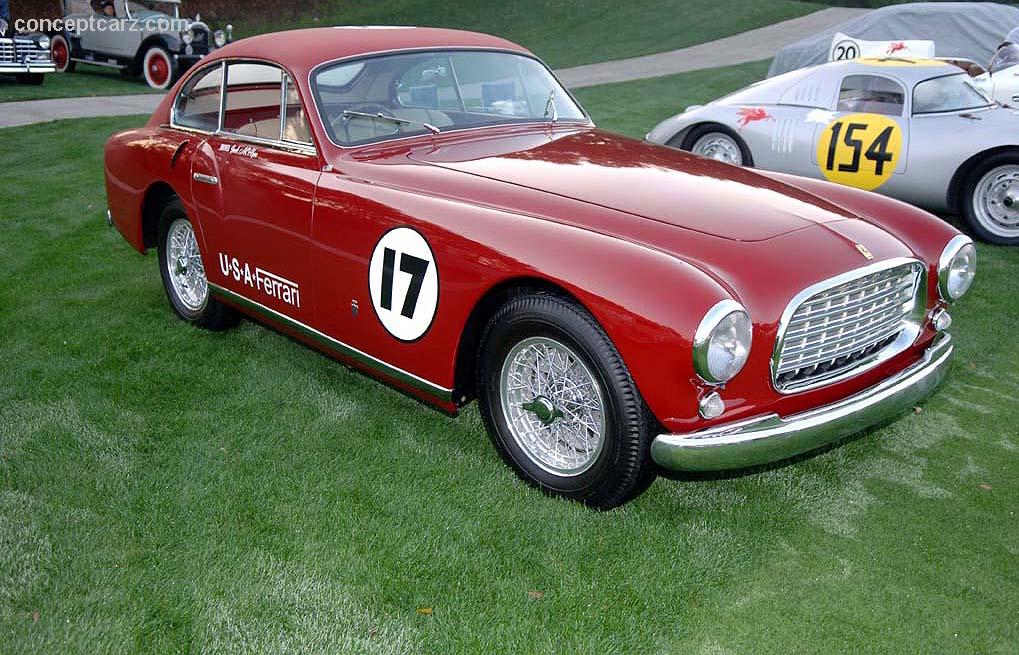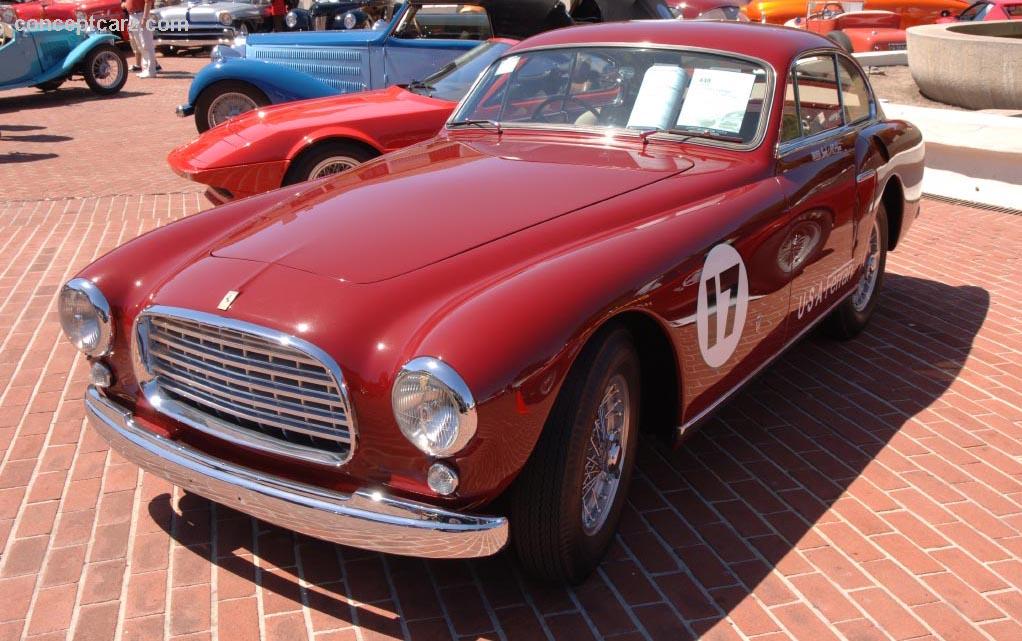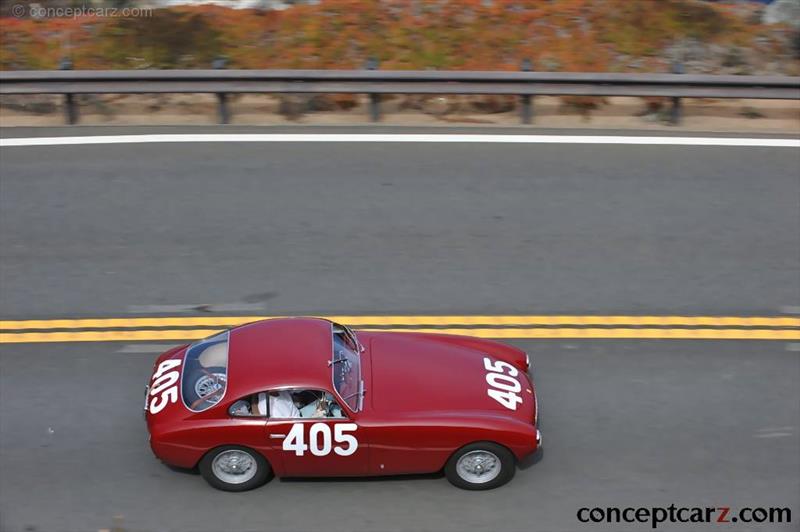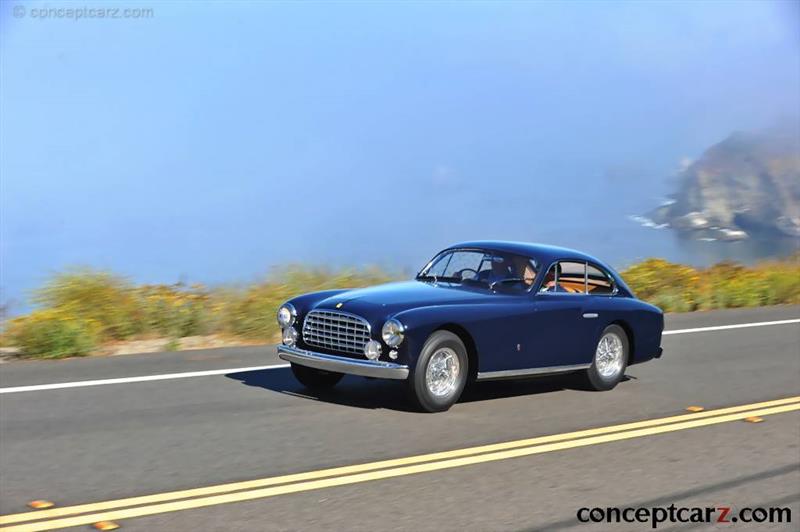Prior to World War II, Giacchino Colombo had been a principle engineer for Scuderia Ferrari. In the postwar era, his 1.5-liter engine in various forms would power models like the 125S, 166MM, and the 212 series. The Colombo short-block V12 would prove significant to Ferrari's evolution with longevity that would span more than a dozen years. Colombo, himself, exited Ferrari early, joining Alfa Romeo in 1950. In his wake, engineer Aurelio Lampredi was brought in to design large naturally aspirated alternatives to the diminutive Colombo-designed V12s used in most Ferrari cars up to that point. The Colombo V12 had thrived in the sports car models, however, it was considerably less successful in the all-important Grand Prix competition format. 
Coupe by Ghia
Chassis #: 0150/A
Engine #: 0150/A
View info and history
Auction entries : 2The immediate postwar period of Grand Prix racing had been dominated by supercharged Alfa Romeo cars that Colombo had designed for them prior to the war on Scuderia's behalf. Their success championed the belief that Grand Prix victories were reliant upon blown motors of relatively small displacement. This setup came at a cost though, as the high-revving motors were particularly susceptible to wear and required high degrees of tuning, parts replacement, and maintenance. While at Ferrari, Colombo had attempted to supercharge his postwar V12 Grand Prix entries, but the short-block engine was unable to outpace the finely tuned and highly developed Alfa unit. Racing regulations dictated small-displacement sizes for blown engines. On the other end of the spectrum, un-supercharged engines could accommodate larger displacement. Lampredi proposed a naturally aspirated 4.5-liter motor with taller and longer architecture, thus prompting the 'long-block' nickname. The design was approved for development by 1949 and featured twin ignition per cylinder and single intake porting. The Lampredi engine powered Scuderia's 1950 Grand Prix cars, and the success was immediate, resulting in Ferrari abandoning further development of the short-block V12 and prompting Colombo's departure. The long-block initially displaced 3.3-liters in the Grand Prix configuration. Versions of 3, 4.1, 4.5, and 5 liters were eventually developed, and powered Ferrari's sport car racing campaigns for the following five years, and were the major force behind their World Sportscar Championships of 1953 and 1954. 
Coupe by Ghia
Chassis #: 0150/A
Engine #: 0150/A
View info and history
Auction entries : 2After the disastrous accident at Le Mans in 1955, displacement limitations were imposed by the FIA which signaled the end of the long-block's campaign. This opened the door for Colombo's original short-block design to re-appear, being installed in such legendary vehicles as the 250 Testa Rossa and Tour de France Berlinetta. The 340 America
Two Ferrari 275 S were entered in the 1950 Mille Miglia, one driven by Alberto Ascari and the other by Luigi Villoresi. These Touring-bodied Barchetta's were powered by the 3.3-liter Grand Prix motor designed by Lampredi. During one of the final stages of the race, both Ferrari's suffered transmission failures. This was followed a few months later by the introduction of a 4.1-liter Lampredi engined car, shown at the Paris Motor Show in September of 1950. These new larger-engined cars were called the 340 America, designed to compete in the United States, specifically in SCCA competition where large-bore sports cars excelled.The car shown at the Paris Motor Show was 0030 MT. The first production example was chassis number 0082A, a Vignale-bodied Berlinetta which made its debut in April 1951 at the Mille Miglia. It was driven by Villoresi and Piero Cassini to first-place overall. Its success helped spawn 22 additional purpose-built 340 America examples, all receiving even-numbered chassis designations which signaled their competition intent. Despite their race-bred intentions, eight of the 23 cars were clothed as road-going examples. Touring and Vignale provided both open and closed coachwork for 19 examples, and Ghia built four Coupe.
by Daniel Vaughan | Nov 2019

Coupe by Ghia
Chassis #: 0150/A
Engine #: 0150/A
View info and history
Auction entries : 2

Coupe by Ghia
Chassis #: 0150/A
Engine #: 0150/A
View info and history
Auction entries : 2
Two Ferrari 275 S were entered in the 1950 Mille Miglia, one driven by Alberto Ascari and the other by Luigi Villoresi. These Touring-bodied Barchetta's were powered by the 3.3-liter Grand Prix motor designed by Lampredi. During one of the final stages of the race, both Ferrari's suffered transmission failures. This was followed a few months later by the introduction of a 4.1-liter Lampredi engined car, shown at the Paris Motor Show in September of 1950. These new larger-engined cars were called the 340 America, designed to compete in the United States, specifically in SCCA competition where large-bore sports cars excelled.The car shown at the Paris Motor Show was 0030 MT. The first production example was chassis number 0082A, a Vignale-bodied Berlinetta which made its debut in April 1951 at the Mille Miglia. It was driven by Villoresi and Piero Cassini to first-place overall. Its success helped spawn 22 additional purpose-built 340 America examples, all receiving even-numbered chassis designations which signaled their competition intent. Despite their race-bred intentions, eight of the 23 cars were clothed as road-going examples. Touring and Vignale provided both open and closed coachwork for 19 examples, and Ghia built four Coupe.
by Daniel Vaughan | Nov 2019
Related Reading : Ferrari 340 America History
The 340 America was introduced in 1950 at the Paris Auto Show and was the first road car to be powered by the Lampredi engine. It was a 4102cc V-12 producing 220 bhp. Early Ferrari automobiles were custom-built cars and were not mass-produced. Ferrari provided the engine and chassis while Italian coachbuilders created the coachwork, leading to various specifications. The bodies of the 340 America....
Continue Reading >>
Continue Reading >>
Related Reading : Ferrari Type 340 History
It was in 1948 when the newly formed Italian automobile company named Ferrari began selling a promising sports car named the 166. The two-seater sports car featured a 12-cylinder engine mounted in the front and supplying over 100 horsepower to the rear wheels. The engine was just under two-liters in size and had a unitary displacement of 166 cc, thus, the evolution of the model name. Production would....
Continue Reading >>
Continue Reading >>
Carrera Panamericana Vehicles
Similar Vehicles
1951 Ferrari 340 America Vehicle Profiles
Recent Vehicle Additions
Related Automotive News

Phenomenal Ferraris and Italian Thoroughbreds Offered at Gooding & Company's Pebble Beach Auctions
The auction house announced a stable of Italian star cars, including a 1950 Ferrari 166 MM Berlinetta Le Mans, a 1961 Ferrari 400 Superamerica Series I Coupe Aerodinamico, and a 1954 Ferrari 500 Mondial Series I Spider.
A stunning group of star...

1938 Mercedes-Benz 540K Autobahn Kurier Named Best of Show at the 70th Pebble Beach Concours d'Elegance
Long recognized as a superlative showcase of automotive history, the Pebble Beach Concours dElegance made history of its own at the culmination of its 70th celebration a total of 38 former Best of Show cars were on hand to welcome a new winner to their...

2015 Pebble Beach Concours d'Elegance Best of Show
PEBBLE BEACH, Calif. (August 17, 2015) -- An Italian Isotta Fraschini Tipo 8A Cabriolet that once turned heads and garnered top prizes in the classic era glided to victory at the 65th Pebble Beach Concours dElegance on Sunday.
The competition...

LANDMARK FERRARI 275S/340 AMERICA BARCHETTA LEADS EARLY HIGHLIGHTS FOR RM SOTHEBY'S FLAGSHIP MONTEREY AUCTION
RM Sothebys secures 1950 Ferrari 275S340 America Barchetta, chassis 0030 MT, for its flagship Monterey sale, August 14-15 in California
A Scuderia Ferrari 12-cylinder Barchetta, 0030 MT was raced by such legends in period as Alberto Ascari, Gio...

1954 Carrera Panamericana: Courage to Go On
Suddenly the Ferrari 340 Mexico would break loose on Hill. Careening down over the ledge, the car would be battered and bruised, coming to a rest finally with its occupants none the worse for wear. It would be a scary moment and the mangled bodywork...









































